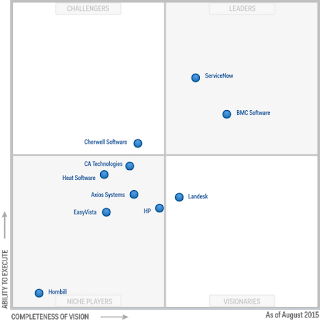BMC Software and ServiceNow are positioned in the Leaders quadrant. Both vendors have executed well, and own 26% and 29%, respectively, of the ITSSM market. Both vendors exhibit the levels of marketing and sales capabilities required to drive market acceptance.
Notable Vendors
Vendors included in this Magic Quadrant Perspective have customers that are successfully using their products and services. Selections are based on analyst opinion and references that validate IT provider claims; however, this is not an exhaustive list or analysis of vendors in this market. Use this perspective as a resource for evaluations, but explore the market further to gauge the ability of each vendor to address your unique business problems and technical concerns. Consider this research as part of your due diligence and in conjunction with discussions with Gartner analysts and other resources.
The notable vendors chosen below were referenced frequently in survey and client inquiry data as offering the most common incumbent products for midmarket organizations.
BMC
BMC offers four ITSSM solutions. One of those products is Remedyforce, which is well-suited for midmarket organizations. Remedyforce is a multitenant SaaS product built on the Salesforce platform, and offers solid ITSSM capabilities at an affordable price point that is well-suited for midmarket organizations.
Dell Kace
Dell Kace provides K1000 Service Desk, a solution that's tightly integrated with IT asset management (ITAM), configuration management, reporting and alerting capabilities. Kace can also integrate to provide endpoint security support, reducing the resources required for managing devices.
Entry Software
Entry Software's TeamHeadquarters is a solution that comes with ITSSM capabilities in both on-premises and SaaS solutions. Its solution module comes complete with core ITIL-based processes, a self-service portal, queue dashboards and asset management. TeamHeadquarters can also integrate with Entry Software's project management solution to create a holistic view of resource utilization.
Heat Software
Heat Software offers an ITSSM product, Heat Service Management, that targets the midmarket to midenterprise. The product is available in both an on-premises and a SaaS-based model off the same codebase. Heat Service Management provides deep ITSSM capabilities, including endpoint operations management capabilities. In addition, Heat Software offers flexible licensing in terms of named and concurrent licensing, providing flexibility for an organization.
ITinvolve
ITinvolve's Service Manager provides a SaaS offering across team workspaces for improved collaboration. The product has ITSSM capabilities with high levels of collaboration, enabling users to leverage individualized visualizations and scenarios to identify and resolve issues. The solution also includes a unified self-service portal for incidents, requests and knowledge management.
ManageEngine
ManageEngine caters to the midmarket with its product, ServiceDesk Plus. The solution is delivered both on-premises and SaaS. It contains integration capabilities to other elements of the ManageEngine portfolio, such as OpManager or Desktop Central.
Samanage
Samanage offers products for ITSSM and IT asset management. Samanage's offering, of the same name, is built to suit midmarket clients. The vendor offers simple pricing with annual subscriptions, and options to subscribe to ITSSM, or to ITSSM integrated with its ITAM offering.
ServiceNow
ServiceNow provides SaaS products for ITSSM. ServiceNow Express targets midmarket clients. The product is a "lite" version of the vendor's full ITSSM suite, and is a good steppingstone for organizations looking to grow into the full suite as they grow or scale.
SunView Software
SunView Software offers ChangeGear, an ITSSM tool, either on-premises or in the cloud. ChangeGear has codeless design and is configurable without technical expertise. It also has flexible licensing at a reasonable price point.
SysAid
SysAid produces SysAid ITSM offered on-premises or as a SaaS model, that focuses on core ITSSM functionality, and targets the midmarket. The product includes a basic benchmarking feature that enables customers to compare several metrics against averages from other SysAid customers. SysAid offers varied subscription options; including a lifetime subscription.
TeamDynamix
TeamDynamix provides cloud-based ITSSM software built for the higher education vertical. Its service management solution offers solid ITSSM and platform capabilities, including a brandable self-service portal and asset and configuration management. Additionally, TeamDynamix seamlessly integrates ITSSM, portfolio, project and resource management into its work management platform.
TOPdesk
TOPdesk produces an ITSSM solution, of the same name, that is available on-premises or as SaaS, and is modular in nature. It offers simple pricing terms based on the number of business users supported.
Sent from my iPadc





